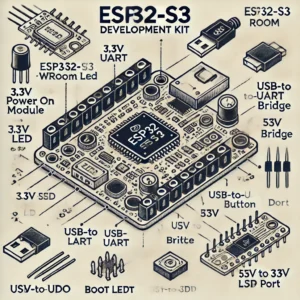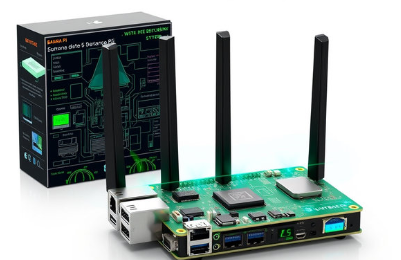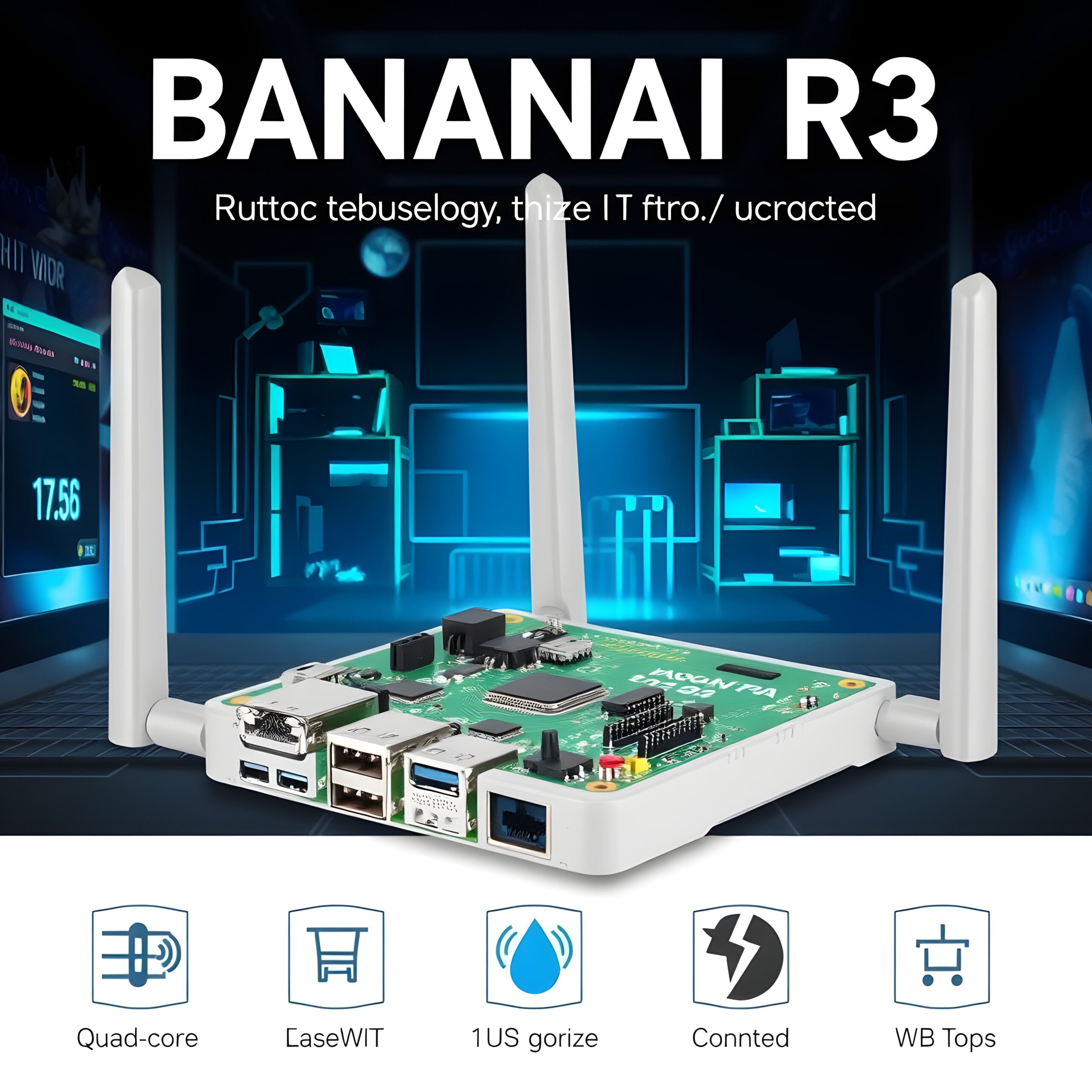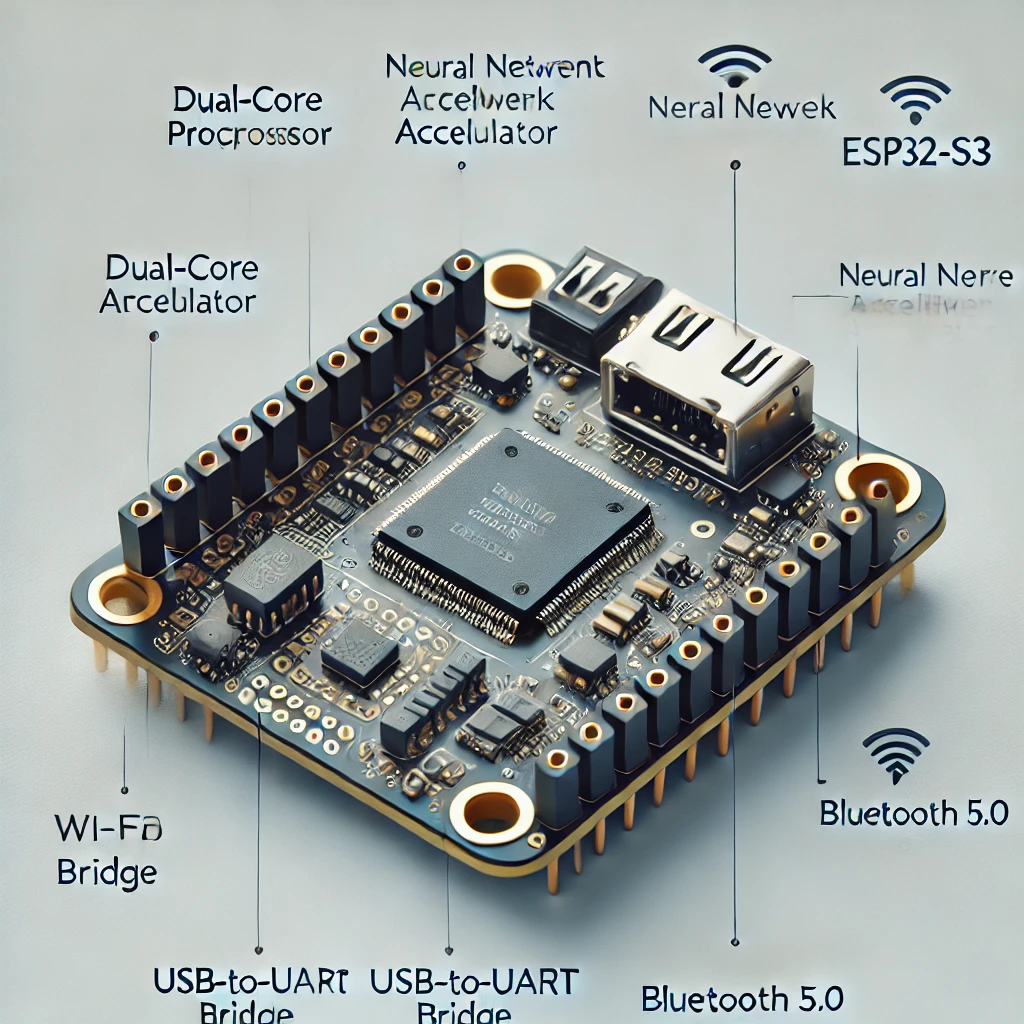Discover how ESP32-S3 development kits revolutionize AI, enhancing edge computing with features like voice recognition and low-power capabilities.
ESP32-S3 Development Kits
The ESP32-S3, developed by Espressif Systems, is an advanced microcontroller designed to handle a range of edge AI tasks. As edge computing continues to take center stage in the Internet of Things (IoT) and artificial intelligence (AI) spaces, the ESP32-S3 development kits have emerged as a key enabler of smart, AI-driven applications that can run efficiently in real-time without relying on cloud services.
At the heart of the ESP32-S3 lies a powerful dual-core Xtensa LX7 processor. This chip is optimized to handle computationally intense AI tasks, making it a standout solution for developers focused on creating AI applications at the edge. The ESP32-S3 includes a dedicated neural network processing unit (NPU), which accelerates machine learning (ML) inference and supports popular frameworks such as TensorFlow Lite. By incorporating this hardware acceleration, the ESP32-S3 can perform AI tasks like voice recognition, image processing, and sensor data analysis in a fraction of the time it would take on traditional processors.
In addition to its AI capabilities, the ESP32-S3 provides robust connectivity options, including dual-band Wi-Fi and Bluetooth 5.0. These features are essential for building scalable IoT networks that require reliable communication, whether you’re building a smart home system, wearable devices, or industrial IoT solutions.
What makes the ESP32-S3 particularly compelling is its combination of high processing power with low power consumption. The development kit is designed to help developers build long-lasting, battery-powered AI applications, making it ideal for use in remote sensors, wearables, and other IoT devices.
Features and Specifications
The ESP32-S3 is loaded with features designed to facilitate advanced AI applications and improve the efficiency of IoT systems. Below is a closer look at some of its most notable specifications:
1. AI Capabilities:
One of the most powerful aspects of the ESP32-S3 is its AI capabilities. The chip is equipped with dedicated hardware for machine learning tasks, including an NPU (neural network processing unit) that accelerates AI workloads such as deep learning and signal processing. The NPU supports TensorFlow Lite and other machine learning frameworks, enabling developers to run AI models directly on the chip.
Additionally, the ESP32-S3 supports vector instructions, which further enhance its ability to process machine learning algorithms efficiently. This makes it a great option for real-time AI tasks that would otherwise require cloud-based processing or external computing resources.
2. Connectivity Options:
The ESP32-S3 comes with dual-band Wi-Fi (2.4 GHz and 5 GHz), which allows for fast and reliable connectivity in diverse environments. Wi-Fi connectivity ensures seamless communication with the cloud or local networks, making it suitable for a wide range of IoT applications.
The chip also supports Bluetooth 5.0, which provides faster data transfer and longer range than previous Bluetooth versions. Bluetooth Low Energy (BLE) is particularly useful in battery-operated devices such as wearables, where power efficiency is crucial.
3. Hardware Specifications:
The ESP32-S3 features 320 KB of SRAM and 384 KB of ROM, allowing for efficient real-time data processing. The chip can also be equipped with up to 16 MB of external Flash storage, giving developers plenty of room for larger applications, including AI models, databases, and more.
The chip’s architecture is designed for low power consumption, with multiple power-saving modes that are ideal for battery-operated devices. Whether in deep sleep or active mode, the ESP32-S3 is highly energy-efficient, ensuring that AI-driven applications can run longer without frequent battery changes.
Applications in Real-World AI Projects
The versatility of the ESP32-S3 makes it well-suited for a wide range of AI applications, particularly those that require real-time processing at the edge. Here are some examples of real-world AI projects enabled by the ESP32-S3:
1. Voice Assistants:
Voice-controlled devices are becoming an integral part of homes and businesses. The ESP32-S3 is ideal for building offline voice assistants, capable of recognizing voice commands without requiring an internet connection. This is particularly useful in situations where privacy is a concern or where internet connectivity is unreliable. The chip’s AI accelerators make it possible to implement efficient voice recognition models that can understand commands, process speech, and trigger responses in real-time.
2. Smart Cameras:
The ESP32-S3 can process images locally, allowing for applications such as facial recognition, object detection, and motion sensing. This capability is particularly valuable in security cameras, where image data must be processed quickly to trigger alerts, send notifications, or take appropriate actions like locking doors or activating alarms. Developers can integrate the ESP32-S3 with AI-driven image processing libraries to perform tasks like real-time video analysis, surveillance, and monitoring in various environments.
3. Industrial IoT:
In industrial settings, the ESP32-S3 can be used for predictive maintenance, anomaly detection, and equipment monitoring. By leveraging its AI capabilities, the chip can analyze sensor data in real time and predict equipment failures before they occur. This type of proactive maintenance reduces downtime, lowers repair costs, and extends the lifespan of machinery. Additionally, the chip’s connectivity features allow it to easily integrate with industrial networks, ensuring smooth data transfer between devices and control systems.
4. Wearables and Health Monitoring:
The compact size and low power consumption of the ESP32-S3 make it an excellent choice for wearable devices. It can be used for health monitoring applications, such as fitness trackers, ECG monitors, or smartwatches. By processing data locally, the ESP32-S3 can detect irregularities like heart rate fluctuations, provide real-time feedback to users, and store health metrics for later analysis—all without needing a constant internet connection.
Development Kits: What’s Included?
The ESP32-S3 development kits are designed to help developers get started quickly with building AI-driven IoT applications. Here’s what you’ll find included in the development kit:
1. ESP32-S3 Chip:
The core of the development kit is the ESP32-S3 chip itself. Pre-programmed with a basic bootloader and example firmware, the chip is ready for developers to start coding right out of the box. The chip includes GPIO pins for interfacing with external sensors, LEDs, motors, and other peripherals, giving developers full control over the hardware.
2. AI Libraries:
Espressif provides pre-integrated AI libraries, including TensorFlow Lite for Microcontrollers, which allows developers to run machine learning models on the ESP32-S3. These libraries make it easy to implement tasks like speech recognition, image classification, and sensor data analysis, without needing advanced knowledge of AI algorithms.
3. Development Board:
The development board includes the ESP32-S3 chip along with connectors for power, debugging, and peripheral devices. It usually comes with several built-in sensors, such as accelerometers, microphones, or temperature sensors, to facilitate rapid prototyping. The board also features a USB connection for easy programming and debugging.
4. Sample Projects:
Most ESP32-S3 development kits include several sample projects to help developers get started. These projects demonstrate how to use the various features of the chip, such as machine learning inference, sensor data collection, and wireless communication. Developers can modify these projects to suit their specific needs or use them as a foundation for more complex applications.
How to Get Started with ESP32-S3
Getting started with the ESP32-S3 development kits is relatively simple. Here’s a step-by-step guide:
1. Setting Up the IDE:
To program the ESP32-S3, you’ll need to install the appropriate Integrated Development Environment (IDE). Espressif’s ESP-IDF (IoT Development Framework) is the most powerful and feature-rich IDE for this platform. Alternatively, you can use the Arduino IDE, which is simpler for beginners and supports a wide range of pre-built libraries.
2. Connecting the Development Kit:
Once your IDE is set up, connect the ESP32-S3 development board to your computer using a micro-USB cable. Most boards are plug-and-play, so the necessary drivers should install automatically.
3. Programming the Device:
Once connected, you can upload code to the ESP32-S3 via the IDE. Start by using sample code or writing custom scripts to interact with sensors, perform AI tasks, or control other devices. The ESP32-S3 supports multiple programming languages, including C++, Python (via MicroPython), and JavaScript (via NodeMCU).
4. Testing and Deployment:
After writing and uploading your code, you can test your application directly on the device. The ESP32-S3 allows for real-time testing, so you can monitor performance and tweak parameters on the fly. Once you’re satisfied, you can deploy the device into your IoT system or stand-alone application.
Future Prospects for ESP32-S3
The future looks promising for the ESP32-S3, particularly as edge AI continues to grow. Espressif is expected to release additional software updates and AI libraries that will make it even easier to implement cutting-edge AI algorithms. Furthermore, the growing ecosystem of third-party modules and accessories will continue to expand the use cases for the ESP32-S3, from agriculture to healthcare and beyond.
As the demand for autonomous IoT devices increases, the ESP32-S3 will play a key role in delivering real-time AI solutions. Its low power consumption and advanced processing capabilities make it the ideal choice for a range of edge computing applications, from smart cities to industrial automation.
FAQ
1. What makes the ESP32-S3 unique for AI?
The ESP32-S3 features a neural network processing unit (NPU) that accelerates machine learning inference. It also supports TensorFlow Lite for microcontrollers, making it highly efficient for AI tasks on embedded systems.
2. Can I use ESP32-S3 for offline AI tasks?
Yes, the ESP32-S3 can perform AI tasks locally, which makes it perfect for applications that require real-time data processing without relying on the cloud.
3. What programming languages are supported?
The ESP32-S3 supports programming in C, C++, Python (via MicroPython), and JavaScript (via NodeMCU).
4. What IDE should I use?
The recommended IDE for advanced projects is the ESP-IDF, but Arduino IDE is also an excellent choice for beginners due to its simplicity and vast library support.
5. Is the ESP32-S3 suitable for beginners?
Yes, the ESP32-S3 is beginner-friendly, and Espressif provides a wealth of documentation and example projects to help new developers get started.
6. Can I integrate it with cloud services?
Yes, you can integrate the ESP32-S3 with cloud platforms like AWS and Azure, making it ideal for scalable IoT deployments that require both edge processing and cloud connectivity.
7. How secure is the ESP32-S3?
The ESP32-S3 includes hardware encryption features, secure boot, and flash encryption, providing robust security for IoT applications.
8. What power options are available?
The ESP32-S3 can be powered via USB or through external power sources such as batteries. It supports multiple low-power modes, which makes it suitable for battery-operated applications.
9. Can it handle heavy AI tasks?
The ESP32-S3 is optimized for lighter AI tasks like speech recognition and image processing. However, it may not be suitable for highly computationally intensive AI tasks like deep learning training.
10. How much does an ESP32-S3 development kit cost?
ESP32-S3 development kits are priced between $10 and $30, depending on the specific model and features included.
11. Does it support TensorFlow?
Yes, the ESP32-S3 supports TensorFlow Lite for microcontrollers, which enables developers to run AI models directly on the chip.
12. What are common use cases?
Common use cases include voice assistants, smart cameras, industrial IoT systems, health monitoring devices, and wearable technology.
13. Can I expand its storage?
Yes, the ESP32-S3 can be paired with external Flash or SD cards for additional storage.
14. Is it compatible with Raspberry Pi?
While not directly compatible, the ESP32-S3 can communicate with Raspberry Pi through standard protocols like UART, I2C, and SPI.
15. How do I get started?
To get started, purchase a development kit, install the ESP-IDF or Arduino IDE, and explore sample projects to learn how to program the ESP32-S3 for your application needs.






